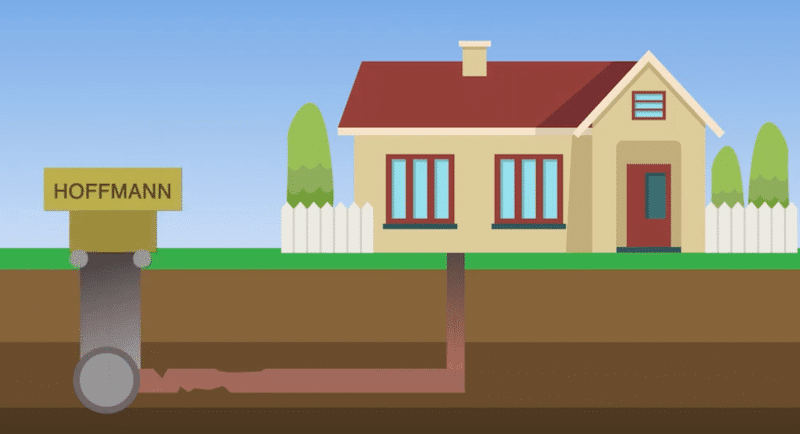
Sewer line bursting is when a licensed plumber pulls a same-size or larger pipe through the existing pipe, using a hydraulic or pneumatic expansion head, a cable, and a winch. The original pipe bursts as the new pipe gets installed – all with little disturbance to your landscaping. Sections of the replacement pipe are heat-welded above ground, so your connections are strong and long-lasting.
Pipe Bursting Table of Contents
Click any below to jump to content
- When To Use Pipe Bursting
- Common Types of Sewer Pipe Bursting
- The Pipe Bursting Process
- Origins of Trenchless Pipe Bursting
- Related Terms to Know
- Use “Sewer Pipe Bursting” in a Sentence
- Benefits of Sewer Pipe Bursting
- Popular Questions About Pipe Bursting
- Other Helpful Resources
When to Use Pipe Bursting for Sewer Replacement or Repairs
When your home has pipes that are cracked, leaking, damaged and causing a mess, pipe bursting may be an ideal method for trenchless sewer repair or replacement. Trenchless sewer repair and replacement can save time, labor, and expense as well as your yard, landscaping, and driveway. Sewer pipe bursting can be considered one of the top options of replacement alongside the popular sewer pipe lining method.
Pipe bursting sewer line replacement is “most appropriate for pipes with an inside diameter range of 100 mm to 600 mm (4 in. to 24 in.),” according to the Environmental Protection Agency (EPA). Many professional plumbers, including Hoffmann Brothers, use this method for sewer lateral lines that range from about 4 to 6 inches in diameter.
Popular Types of Sewer Pipe Bursting
There are two main classes of trenchless pipe bursting: static full and pneumatic. The main differences between these systems are: the energy source, the breaking method, and the operation.
- Static pull systems, the preferred method used by Hoffmann Brothers, bring the cone-shaped expansion head through a rod or a cable through the existing pipe with the help of a hydraulic unit’s constant force (think up to 30 tons of pulling pressure), breaking it as it moves through and creating space for the new pipe.
- Pneumatic systems are driven by compressed air and break the existing pipes like a hammer putting a nail in a wall.
The Pipe Bursting Process
The trenchless pipe bursting method is an alternative to sewer pipe lining that creates small entry and exit points above ground, pushes (or pulls) a new sewer pipe through an older damaged one, and bursts the existing pipe as it moves along the line.
The process typically goes like this:
- Sewer Camera Inspection – A licensed plumber will insert a specially designed high-resolution video camera into your sewer pipe and transmit the video back in order to locate the depth and location of your existing sewer line as well as the source of your sewer line problems.
- Dig Small Entry and Exit Points – Two small entry and exit points are dug near your foundation and your property line.
- Weld New Pipes in Place with Heat – The new sewer pipe is heat welded above ground to ensure no breaks or tree roots causing problems with your sewer line in the future.
- Burst Old Pipes by Pulling New Pipes Through – Mechanically pull the new pipe through the old pipe – bursting the old and installing the new at the same time.
Origins of Trenchless Pipe Bursting
D.J. Ryan & Sons and British Gas in the United Kingdom first developed pipe bursting in the 1970s to replace gas mains.1 The method was patented in 1981 (UK) and 1986 (USA) before expiring in 2005 and presenting the opportunity for further development of sewer and water line pipe bursting.
These first advancements in pipe bursting trenchless technology, while revolutionary, created quite a mess. Pipe bursting sewer replacement involved tearing up and digging in yards, driveways, and sidewalks as well as demolishing any landscaping in the way before pipe bursting sewer repair presented a less invasive solution.
Plumbing contracts started with slip lining, then developed trenchless pipe bursting and pipe splitting methods, and now incorporate pipe lining to give homeowners solutions to their sewer line troubles.
Trenchless Pipe Bursting – Related Terms
The most common words and phrases often used interchangeably with the sewer pipe bursting process include:
- Pipe bursting
- Pipe bursting sewer replacement
- Pipe bursting water line replacement
- Pipeline bursting
- Sewer line pipe bursting
- Sewer pipe bursting
- Sanitary sewer pipe bursting
- Trenchless pipe bursting
- Waterline pipe bursting
Sewer Pipe Bursting Used in a Sentence
Let’s have a trusted local plumbing contractor replace our sewer lines using sewer line bursting since it won’t require digging up our entire yard.
The Benefits of Sewer Pipe Bursting
The benefits of using the pipe bursting method include:
- Avoiding excavation and replacement of yard landscaping, driveways, and/or sidewalks
- Minimizes property damage
- Reduces risk of damaging underground utilities and injury to laborers
- Up to a 100-Year pipe lifespan with replacement
- Increases flow capacity by installing equal or larger-diameter pipes
- Targets root intrusion and helps reduce erosion of pipes
- No need to stop traffic during work
- More than 1,000 ft. of pull length can be used
- Most types of existing pipe materials (other than HPDE and some ductile iron and reinforced concrete) can be burst
Frequently Asked Questions About Pipe Bursting
Yes, pipe bursting presents a trenchless alternative to traditional sewer line replacement methods and does the job in less time, labor, and expense. This is largely due to the fact that pipe bursting does not require digging up (and later replacing) your yard, landscaping, driveway and/or sidewalk.
Hoffmann Brothers guarantees their pipe bursting for 50 years.
High-density polyethylene (HDPE) pipes are used to replace existing pipelines.
Yes, although PVC can only be replaced using static pipe bursting.
Yes, concrete piping is one of the common applications for pipe bursting.
Other Helpful Pages
- Sewer Pipe Lining Definition
- Sewer Smell in Your House?
- How to Unclog a Drain
- Electrical Outlet Fire Safety
- Learning About Geothermal Energy
- Replace Your FPE StabLok Circuit Breaker


